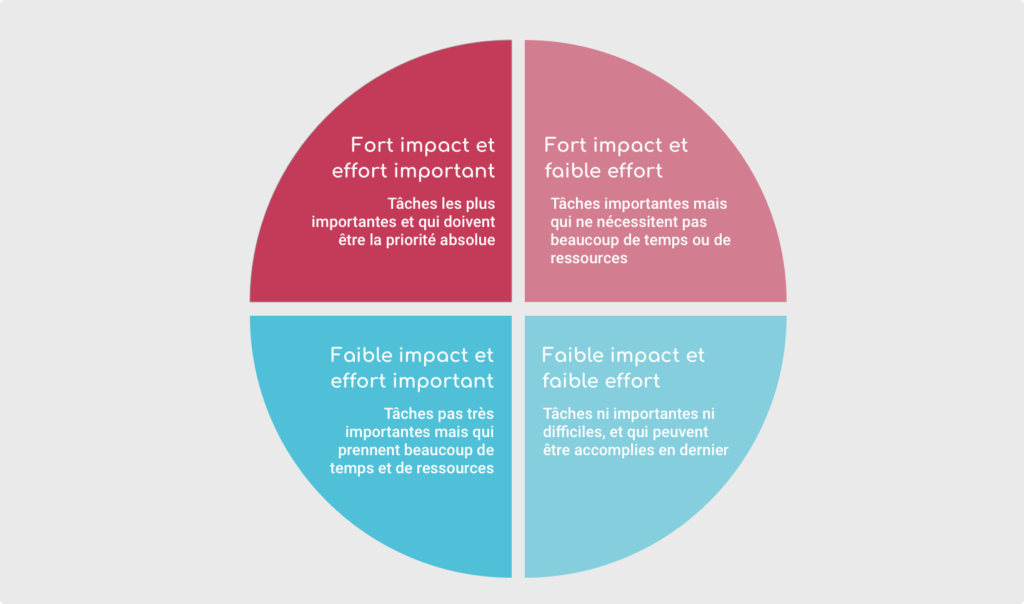Your to-do list is overflowing and you don’t know where to start?
The impact/effort matrix is the essential tool for organizing your tasks simply and effectively. This method helps you focus on priority tasks.
This is a time and priority management tool developed by management consultant Stephen Covey in his book “The 7 Habits of Highly Effective People“.
How to organize your tasks with this method
To use the impact/effort matrix, simply list all the tasks you have to complete and rank them according to their impact and effort.
Impact refers to the importance of the task to your business or personal life. Effort corresponds to the time and resources required to accomplish the task.
Once you’ve categorized your tasks, you can place them in one of the matrix’s four areas:
Zone 1: High-impact, high-effort tasks.
These tasks are the most important and require the most time and resources. They should be your top priority.
Zone 2 : High-impact, low-effort tasks.
These tasks are important, but don’t require a lot of time or resources. They should be your second priority.
Zone 3: Low-impact, high-effort tasks.
These tasks aren’t very important, but they do take up a lot of time and resources. You should try to delegate or automate them if possible.
Zone 4: Low-impact, low-effort tasks.
These tasks are neither important nor difficult. You should complete them last or perhaps even abandon them if you are short of time.
Using the impact/effort matrix, you can make sure you deal with tasks in order of importance. This tool will help you better organize your tasks and achieve your goals more efficiently.

How to maximize the effectiveness of the impact/effort matrix
- Be honest with yourself by accurately assessing the impact and effort of each task. If you overestimate the importance of a task or underestimate the time it will take, you may find yourself overwhelmed and unable to achieve your goals.
- Make a list of all your tasks before filing them in the matrix. This will ensure that you don’t forget anything and that you have an overview of everything that needs to be done.
- Try to delegate or automate Zone 3 tasks if possible. This will allow you to focus on the most important tasks and free up time for other things.
The impact/effort matrix is a simple tool for organizing your tasks and better managing your time. If you follow these tips, you’ll be able to achieve your day-to-day goals more effectively.
If you’re interested in this method, you can also read reference books in the field of time management, such as “Getting Things Done” by David Allen, “The One Thing” by Gary Keller and Jay Papasan, or “The Productivity Project” by Chris Bailey.
AI NEWSLETTER
Stay on top of AI with our Newsletter
Every month, AI news and our latest articles, delivered straight to your inbox.

CHATGPT prompt guide (EDITION 2024)
Download our free PDF guide to crafting effective prompts with ChatGPT.
Designed for beginners, it provides you with the knowledge needed to structure your prompts and boost your productivity
With this ebook, you will:
✔ Master Best Practices
Understand how to structure your queries to get clear and precise answers.
✔ Create Effective Prompts
The rules for formulating your questions to receive the best possible responses.
✔ Boost Your Productivity
Simplify your daily tasks by leveraging ChatGPT’s features.
Similar posts
Warning: Undefined array key "settings" in /home/clients/eb0711d6c98c1705827ba5b7dfe89477/sites/anthemcreation.com/wp-content/plugins/bb-ultimate-addon/modules/uabb-woo-products/uabb-woo-products.php on line 158
Warning: Attempt to read property "type" on null in /home/clients/eb0711d6c98c1705827ba5b7dfe89477/sites/anthemcreation.com/wp-content/plugins/bb-ultimate-addon/modules/uabb-woo-products/uabb-woo-products.php on line 158
Sorry, we couldn't find any posts. Please try a different search.